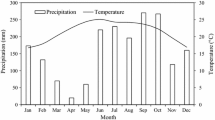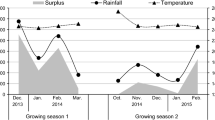Abstract
Plant growth, morphology and nutritive value under shade can differ between temperate grasses. Therefore, the aim of this study was to quantify the dry matter (DM) production, sward morphology, crude protein (CP%), organic matter digestibility (OMD) and macro-nutrient concentrations (P, K, Mg, Ca and S) in a grazed cocksfoot (Dactylis glomerata L.) pasture under 10-year-old Pinus radiata D. Don forest. Four levels of light intensity were compared: full sunlight (100% photosynthetic photon flux density-PPFD), open + wooden slats (∼43% PPFD), trees (∼58% PPFD) and tree + slats (∼24% PPFD). The mean total DM production was 8.2 t DM ha−1 yr−1 in the open and 3.8 t DM ha−1 yr−1 in the trees + slats treatment. The changes in cocksfoot leaf area index (LAI) were related to variations in morphological aspects of the sward such as canopy height and tiller population. CP% increased as PPFD declined with mean values of 18.6% in open and 22.5% in the trees + slats treatment. In contrast, the intensity of fluctuating shade had little effect on OMD with a mean value of 79 ± 3.2%. The mean annual macro-nutrient concentrations in leaves increased as the PPFD level declined mainly between the open and the trees + slats treatments. It therefore appears that heavily shaded dominant temperate pastures in silvopastoral systems limit animal production per hectare through lower DM production rates and per animal through reduced pre-grazing pasture mass of lower bulk density from the etiolated pasture.











Similar content being viewed by others
References
Anderson GW (1978) Productivity of crops and pastures under trees. In: Howes KMW, Rummery RA (eds) Integrated agriculture and forestry. CSIRO, Division of Land Resource Management, Perth, pp 59–63
Braziotis DC, Papanastasis VP (1995) Seasonal changes of understorey herbage yield in relation to light intensity and soil moisture content in a Pinus pinaster plantation. Agroforest Syst 29:91–110
Burton GW, Jackson JE, Knox FE (1959) The influence of light reduction upon the production, persistence and chemical composition of Coastal Bermudagrass, Cynodon dactylon. Agron J 51:537–542
Casal JJ, Deregibus VA, Sanchez RA (1987) Tillering responses of Lolium multiflorum plants to changes of red/far-red ratio typical of sparse canopies. J Exp Bot 38:1432–1439
Cossens GG (1984) Grazed pasture production under Pinus radiata in Otago. In: Bilbrough GW (ed) Proceedings of a Technical Workshop on Agroforestry. Dunedin, New Zealand, May 1984
Davies A (1988) The regrowth of grass swards. The grass plant – its form and function. In: Jones MB, Lazenby A (eds) The grass crop: The physiological basis of production. Chapman and Hall, London, p 85
Davis MR (1994) Topsoil properties under tussock grassland and adjoining pine forest in Otago, New Zealand. New Zeal J Agr Res 37:465–469
Deregibus VA, Sanchez RA, Casal JJ (1983) Effects of light quality on tiller production in Lolium spp. Plant Physiol 72:900–902
Devkota NR, Kemp PD, Hodgson J (1997) Screening pasture species for shade tolerance. Proc Agron Soc New Zeal 27:119–128
Devkota NR, Kemp PD, Valentine I, Hodgson J (2000) Shade tolerance of pasture species in relation to deciduous tree, temperate silvopastoral systems. Proc Agron Soc New Zeal 30:101–107
Duru M, Lemaire G, Cruz P (1997) Grasslands. In: Lemaire G (ed) Diagnosis of the nitrogen status in crops. Springer, New York
Garnier E, Roy J (1988) Modular and demographic analysis of plant leaf area in sward and woodland populations of Dactylis glomerata and Bromus erectus. J Ecol 76:729–743
Gong Y, Hodgson J, Lambert MG, Gordon IL (1996) Short-term ingestive behaviour of sheep and goats grazing grasses and legumes. 2. Quantitative relationships between sets of sward and ingestive behaviour variables. New Zeal J Agr Res 39:75–82
Hawke MF, Knowles RL (1997) Temperate agroforestry in New Zealand. In: Gordon AM, Newman SM (eds) Temperate agroforestry systems. CAB International, UK, Wallingford
Hawke MF, O’Connor MB (1993) Soil pH and nutrient levels at Tikitere agroforestry research area. New Zeal J For Sci 23:40–48
Hight GK, Sinclair DP, Lancaster RJ (1968) Some effects of shading and of nitrogen fertiliser on the chemical composition of freeze-dried and oven-dried herbage, and on the nutritive value of oven-dried herbage fed to sheep. New Zeal J Agr Res 11:286–302
Joshi MR, Lucas RJ, Sedcole JR, Pollock KM, Moot DJ, Mead DJ (1999) Shading effects of Pinus radiata on productivity and feeding value of orchardgrass pasture. Agroforest Forum 9:17–19
Kemp PD, Condron LM, Matthew C (1999) Pastures and soil fertility. In: White J, Hodgson J (eds) New Zealand pastures and crop science. Oxford University Press, Auckland
Kephart KD, Buxton DR (1993) Forage quality responses of C3 and C4 perennial grasses to shade. Crop Sci 33:831–837
Korte CJ, Chu ACP, Field TRO (1987) Pasture production. In: Nicol AM (ed) Feeding livestock on pasture. New Zealand Society of Animal Production, New Zealand
Lambers H, Chapin III FS, Pons TJ (1998) Plant physiological ecology. Springer-Verlag, New York
Morton J, Roberts AHC, Edmeades DC (1994) Fertiliser use on sheep and beef farms. New Zealand Fertiliser Manufacturers Research Association, Auckland
Norton BW, Wilson JR, Shelton HM, Hill KD (1991) The effect of shade on forage quality. In: Shelton HM, Stur WW (eds) Forages for plantation crops. ACIAR, Canberra
Padmore JM (1990) Animal feed. In: Helrich K (ed) Official methods of analysis. Association of Official Analytical Chemists, Arlington
Peri PL Varella AC, Lucas RJ, Moot DJ (2001) Cocksfoot and lucerne productivity in a Pinus radiata silvopastoral system: a grazed comparison. Proc New Zeal Grassland Assoc 63:139–147
Peri PL, McNeil DL, Moot DJ, Varella AC, Lucas RJ (2002) Net photosynthetic rate of cocksfoot leaves under continuous and fluctuating shade conditions in the field. Grass Forage Sci 57:157–170
Quin BF, Woods PH (1976) Rapid manual determination of sulphur and phosphorus in plant material. Soil Sci Plant Anal 7:415–426
Rahman AAA, Shalaby AF, El Monayeri MO (1971) Effect of moisture stress on metabolic products and ion accumulation. Plant soil 34:65–90
Reynolds SG (1995) Pasture-Cattle-Coconut Systems. FAO, RAPA (Regional Office for Asia and the Pacific), Bangkok
Robson MJ, Ryle GJA, Woledge J (1988) The grass plant – its form and function. In: Jones MB, Lazenby A (eds) The grass crop. Chapman and Hall, London
Sheehy JE, Cooper JP (1973) Light interception, photosynthetic activity, and crop growth rate in canopies of six temperate forage grasses. J Appl Ecol 10:239–250
Sibbald AR, Griffiths JH, Elston DA (1991) The effects of the presence of widely spaced conifers on under-storey herbage production in the U.K. Forest Ecol Manag 45:71–77
Smith H (1982) Light quality, photoperception, and plant strategy. Ann Rev Plant Physiol 33:481–518
Volaire F, Thomas H (1995) Effects of drought on water relations, mineral uptake, water-soluble carbohydrate accumulation and survival of two contrasting populations of cocksfoot (Dactylis glomerata L.). Ann Bot-LONDON 75:513–524
Whitehead DC (1995) Grassland nitrogen. CAB International, Wallingford
Wilson JR (1988) Ecological constraints to production and nutritive quality of pastures under tree crops. In: Livestock-tree cropping production systems. Proc FAO/MARDI Int Workshop, 5–9 December 1988, Serdang, Malaysia
Wilson JR, Ludlow MM (1991) The environment and potential growth of herbage under plantations. In: Shelton HM, Stur WW (eds) Forages for plantation crops. ACIAR, Canberra
Wong CC (1991) Shade tolerance of tropical forage: a review. In: Shelton HM, Stur WW (eds) Forages for plantation crops. ACIAR, Canberra
Author information
Authors and Affiliations
Corresponding author
Rights and permissions
About this article
Cite this article
Peri, P.L., Lucas, R.J. & Moot, D.J. Dry matter production, morphology and nutritive value of Dactylis glomerata growing under different light regimes. Agroforest Syst 70, 63–79 (2007). https://doi.org/10.1007/s10457-007-9029-x
Published:
Issue Date:
DOI: https://doi.org/10.1007/s10457-007-9029-x




